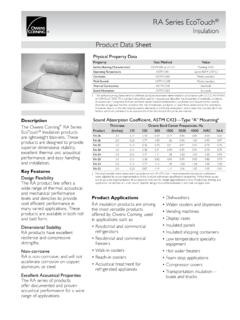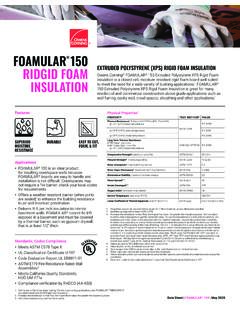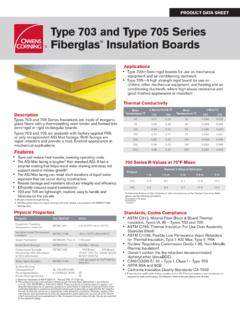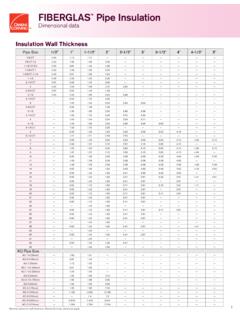Transcription of Extruded Polystyrene (XPS) Rigid Foam Insulation Product ...
1 Product data SheetFOAMULAR DURAPINK Extruded Polystyrene (XPS) Rigid foam InsulationEnergy-Saving1, Moisture-Resistant XPS InsulationXPS Recovery Roofi ng InsulationASTM C578 Type IV, 25 psi minimum DescriptionDURAPINK Roofi ng Recovery Board is an Extruded Polystyrene (XPS) roofi ng Product designed for use with single-ply membranes, including black EPDM2 and other dark-colored single-ply membranes. DURAPINK roofi ng recovery board works without overlay protection, ballast or pavers. DURAPINK roofi ng recovery board saves the trouble and expense of removing the old roof, and adds Insulation and moisture protection to the new one, providing new economy and durability for worn out commercial ng recovery is an increasingly popular means of reroofi ng for aged and trouble-plagued roofs. The decision to recover a roof is based on two compelling reasons: The cost involved in 1 Savings vary.
2 Find out why in the seller s fact sheet on R-values. Higher R-values mean greater insulating EPDM Ethylene Propylene Diene Monomer roofi ng is a type of thermoset membrane roof materialtearing off the old roof, and the cost of disposing of the discarded debris both of which can be signifi cant. When you recover, both costs are avoided. Key Features Excellent long-term stable Insulation performance of R-5 per inch3 Exceptional moisture resistance, long-term durability Recommended for use directly under black EPDM membranes, without the need for protection. Limited lifetime warranty4 maintains 90% of R-value and covers all ASTM C578 properties GREENGUARD Gold Certifi ed The only XPS foam with certifi ed recycled content certifi ed by SCS Global Services to contain a minimum 20% recycled content Will not corrode, rot or support mold growth Zero ozone depletion potential with 70% less global warming potential than our previous formula Reusable and remnants from manufacturing are recycled back into new XPS foam Insulation Lightweight, durable Rigid foam panels are easy to handle and install Easy to saw, cut or score3 R means the resistance to heat fl ow; the higher the R-value, the greater the insulating See actual warranty for complete details, limitations and requirements.
3 Technical Information DURAPINK roofi ng recovery board is to be installed over existing roofs only and not over new Insulation . When installed beneath dark-colored, mechanically attached membranes, some vertical displacement may be noticeable, especially during the high heat of mid-day. Such behavior is normal thermal expansion and contraction of the material. The movement will not affect the integrity of the recover roofi ng membrane or attachment systems. Recovery roofi ng is often done over uneven substrates. Humps, sharp edges or ridges in the existing membrane should be cut out if possible before covering with DURAPINK roofi ng recovery board. If this is not possible, DURAPINK roofi ng recovery board can be placed, but may crack over uneven surfaces when walked on. Examine the existing roof for areas of wet Insulation and/or wet or deteriorated decking. Remove and replace wet or deteriorated material as necessary.
4 All roofs to be recovered should be evaluated for the presence of an existing vapor retarder. Research by the Oakridge National Laboratory (ORNL) suggests that some wet roof systems containing permeable materials can be dried to the interior of a building if no internal vapor retarder is data SheetFOAMULAR DURAPINK Extruded Polystyrene (XPS) Rigid foam Insulation When installing DURAPINK roofi ng recovery board beneath a dark-colored, mechanically attached membrane, Owens Corning recommends the installation of eight fasteners and stress plates per 4'x8' panel. The diagram shows the recommended fastener placement. For fully adhered and ballasted systems, contact the specifi c membrane manufacturer or Owens Corning for fastening recommendations. When installing DURAPINK roofi ng recovery board beneath a white, mechanically attached roof system, a minimum of one fastener per eight square feet is required to secure the board, placed within 6" of each corner of 4'x8' panel.
5 This limited amount of fasteners is acceptable but may allow some board movement. Install two to four additional fasteners in the center fi eld as shown in the fastening diagram for enhanced fl atness. The membrane should be laid out perpendicular to the long dimension of DURAPINK roofi ng recovery board panels. Some membranes, such as PVC containing plasticizers, will require a separator between DURAPINK roofi ng recovery board and the membrane. For roofi ng and other horizontal applications, Product should be installed with the printed surface facing downward. DURAPINK roofi ng recovery board can be installed over coal tar pitch (CTP) provided the existing coal tar is at least ten years old and has not been re-saturated in the last four years. If those age criteria are not met, a 6 mil polyethylene sheet will serve as an adequate separator between CTP and Pattern Diagram24"6"6"24"48"Typical Physical Properties1 DURAPINK Roofi ng Recovery BoardPropertyTest Method2 ValueThermal Resistance3, R-Value (180 day) minimum,hr ft2 F/Btu (RSI, C m2/W)@ 75 F (24 C) mean temperatureASTM C518 " ( )1" ( )@ 40 F ( C) mean temperature " ( )1" ( )Long Term Thermal Resistance, LT TR-Value3, minimumhr ft2 F/Btu (RSI, C m2/W)@ 75 F (24 C) mean temperatureCAN/ULC S770-03 " Thickness4N/A1" ( )Compressive Strength5, minimum psi (kPa)ASTM D1621 " Thickness418 (124)1" Thickness25 (172)Flexural Strength6, minimum psi (kPa)ASTM C20375 (517)Water Absorption7, maximum % by volumeASTM Vapor Permeance8, maximum perm (ng/Pa s m2)ASTM (86)
6 Dimensional Stability, maximum % linear change ASTM Spread9, 10 ASTM E845 Smoke Developed9, 10, 11 ASTM E8445-175 Oxygen Index9, minimum % by volumeASTM D 286324 Service Temperature, maximum F ( C) 165 (74)Linear Coeffi cient of Thermal Expansion, in/in/ F (m/m/ C)ASTM x 10-5 ( x 10-5)1. Proper ties shown are representative values for 1" thick material, unless otherwise specifi Modifi ed as required to meet ASTM R means the resistance to heat fl ow; the higher the value, the greater the Insulation power. This Insulation must be installed properly to get the marked R-value. Follow the manufacturer s instructions carefully. If a manufacturer s fact sheet is not provided with the material shipment, request this and review it carefully. R-values vary depending on many factors including the mean temperature at which the test is conducted, and the age of the sample at the time of testing.
7 Because Rigid foam plastic Insulation products are not all aged in accordance with the same standards, it is useful to publish comparison R-value data . The R-value for FOAMULAR XPS Insulation is provided from testing at two mean temperatures, 40 F and 75 F, and from two aging (conditioning) techniques, 180 day real-time aged (as mandated by ASTM C578) and a method of accelerated aging sometimes called Long Term Thermal Resistance (LTTR) per CAN/ULC S770-03. The R-value at 180 day real-time age and 75 F mean temperature is commonly used to compare products and is the value printed on the The " is actually a nominal half-inch of 9/16th needed to achieve Values at yield or 10% defl ection, whichever occurs fi Value at yield or 5%, whichever occurs fi data ranges from to value shown due to the level of precision of the test Water vapor permeance decreases as thickness These laboratory tests are not intended to describe the hazards presented by this material under actual fi re data from Underwriters Laboratories Inc.
8 Classifi ed. See Classifi cation Cer tifi cate ASTM E84 is thickness-dependent, therefore a range of values is data SheetFOAMULAR DURAPINK Extruded Polystyrene (XPS) Rigid foam Insulation See DURAPINK roofi ng recovery board guide specifi cations for complete installation details. All construction should be evaluated for the necessity to provide vapor retarders. See current ASHRAE Handbook of XPS Insulation can be exposed to the exterior during normal construction cycles. During that time some fading of color may begin due to UV exposure, and, if exposed for extended periods of time, some degradation or dusting of the Polystyrene surface may begin. It is best if the Product is covered within 60 days to minimize degradation. Once covered, the deterioration stops, and damage is limited to the thin top surface layers of cells. Cells below are generally unharmed and still useful Insulation .
9 FOAMULAR XPS Insulation is a thermoplastic material with a maximum service temperature of 165 F. For DURAPINK XPS that is of proper thickness and installed per manufacturers recommendations, installation under a dark membrane is an acceptable application. However, until properly placed and secured, if stored under dark (nonwhite) or clear (non-opaque) materials, in horizontal applications (such as on roof decks), it may experience greater solar exposure and it may be damaged by heat buildup. Simple precautions during construction can minimize the potential for heat related damage. For all horizontal applications always turn the print side down so the black print does not show to the sun which may, at times, act as a solar collector and raise the temperature of the foam surface under the print. Do not cover FOAMULAR XPS Insulation either stored (factory wrapped or unwrapped), or partially installed, with dark colored (non-white), or clear (non-opaque) coverings and leave it exposed to the sun.
10 Examples of such coverings include but are not limited to fi lter fabrics, membranes, temporary tarps, clear polyethylene, etc. If improperly covered, and exposed to the right combination of sun, time and temperature, deformation damage may occur rapidly. When covering is necessary, use only white opaque material, or, cover with the fi nal approved fi nish material as soon as possible. A white opaque cover refl ects energy from the sun rather than absorbing it or passing it which reduces the potential for excessive heat exposure. Clear (non-opaque) coverings allow light energy from the sun to pass through rather than refl ect it which may produce a partial greenhouse effect, trapping hot air and raising the temperature below the cover. See Owens Corning publication number 10015704, Heat Build Up Due to Solar Exposure for more , Codes Compliance Meets ASTM C578 Type IV UL Classifi ed.













